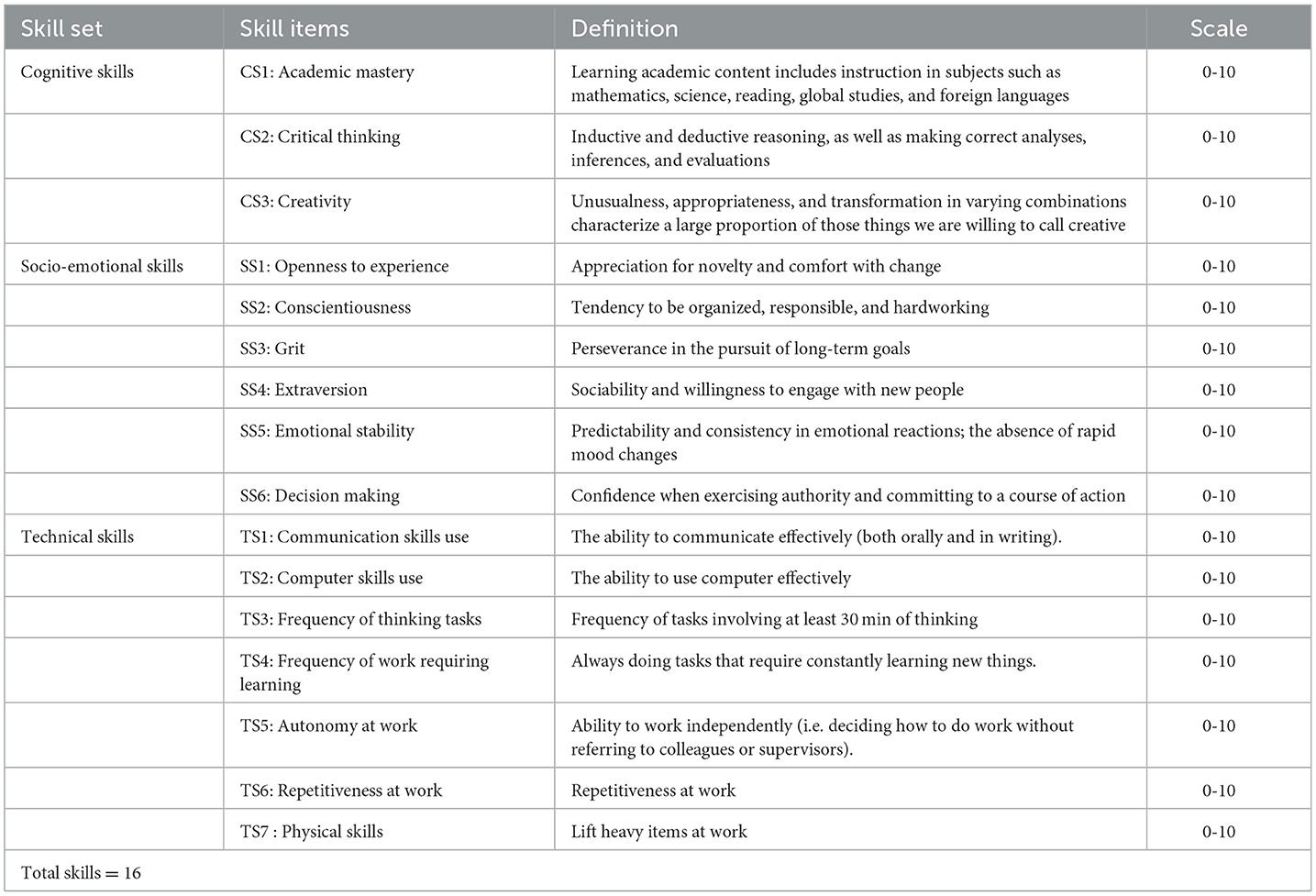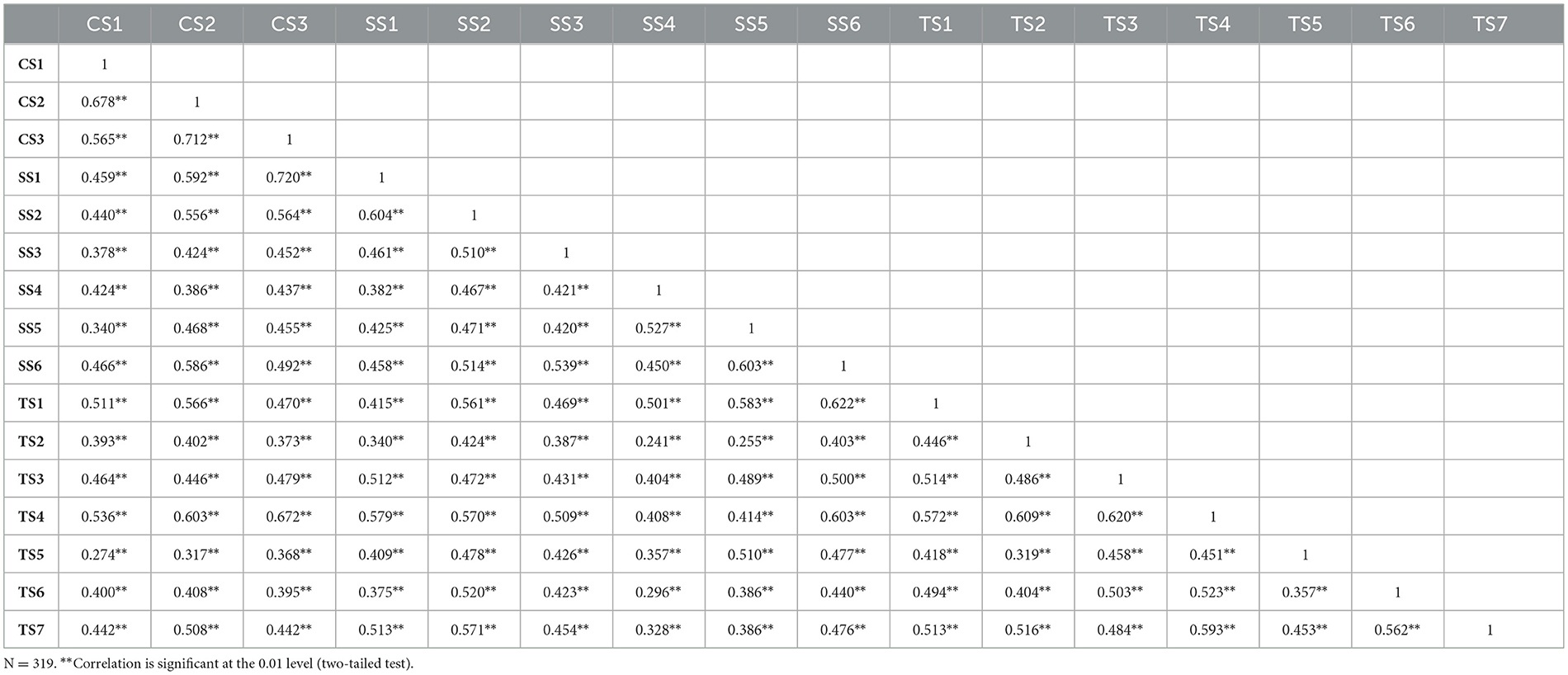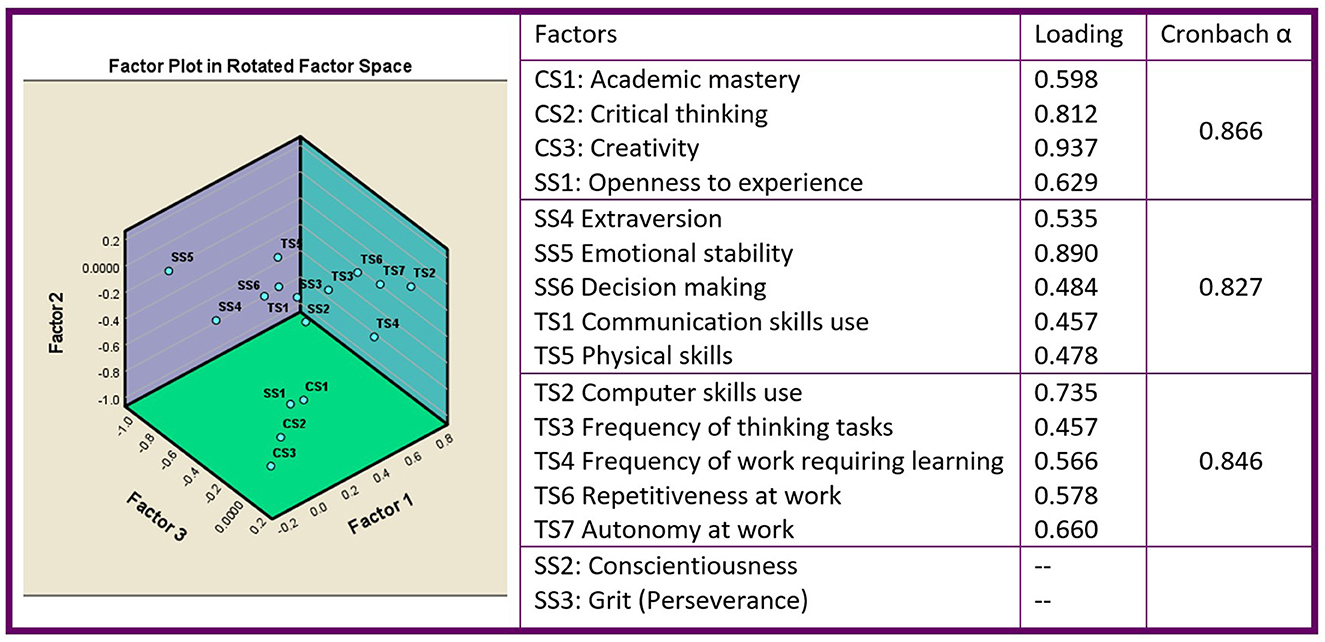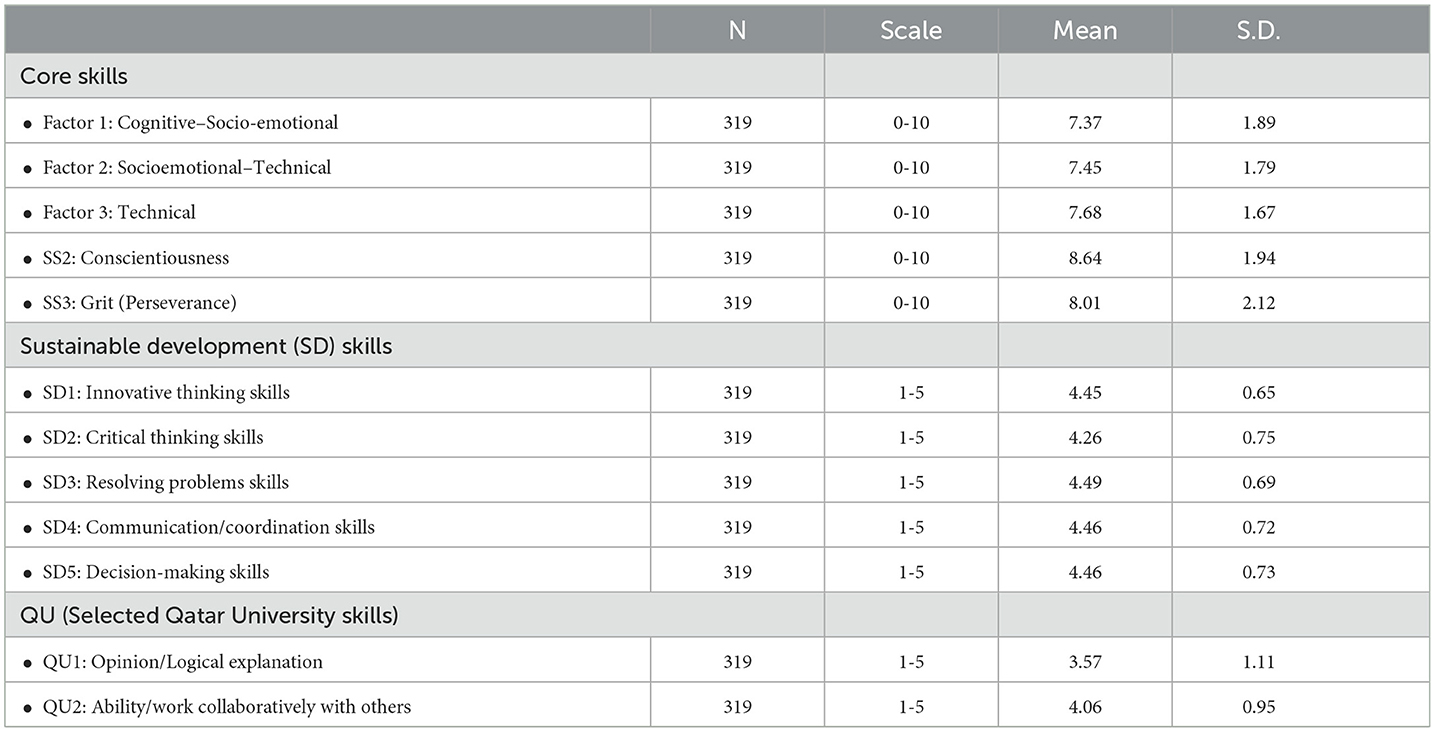- Department of Social Sciences, College of Arts and Sciences, Qatar University, Doha, Qatar
Introduction: The present study investigates the status of education for sustainable development (ESD) as an approach applied to higher education. This study proposes cognitive, behavioral, and socio-emotional learning as the three dimensions of ESD. It examines the extent to which the current curriculum and educational structures applied by Qatar University (QU) contribute to sustainable development (SD) skills in students' attitudes.
Methods: Data from 319 students were collected. Factor analysis was performed to regroup skill items within the consistent dimensions of 16 core skills. A multivariate logistic regression analysis was performed to examine the relationship between core skills and the five SD skills.
Findings: Five logistic regression models were investigated. Model 1 found two predictors that only increase the odds of innovative thinking skills. Model 2 detected five predictors that increase the odds of critical thinking skills. Model 3 defined three predictors that increase the odds of resolving problem skills. Model 4 mentioned four predictors that increase the odds of communication/coordination skills. Model 5 showed two predictors that increase the odds of decision-making skills.
Research implications: This study introduces new core skills that have been reclassified based on students' real-world experiences. Such findings may help target specific skills and bring significant changes in higher education outcomes.
1. Introduction
The components of Education for Sustainable Development (ESD) are not only limited to ecological or environmental aspects but also include economic, social, and educational dimensions, which are cultural (Rayman-Bacchus and Radavoi, 2020; Olafsen et al., 2021). Incorporated in the “2014 Aichi Nagoya Declaration,”1 the 2030 Agenda for Sustainable Development is one of the most widely applied approaches to improve the quality of life for all people on the planet (UNESCO, 2014). Sustainable development (SD) becomes the object of an educational project promoted by both international and national governing bodies, to which the education community is required to commit (Acosta Castellanos and Queiruga-Dios, 2022). One of the most recent events related to this substantive theme is the World Conference on ESD, a virtual conference held in Berlin in May 2021. To promote awareness of the challenges of SD and reaffirm global commitments to “ESD 2030,” the conference amassed both decision-makers and professionals involved in education and SD around the world. A series of key issues discussed at the Conference include the promotion of transformative education to support learners who are responsible and actively contribute to building a more sustainable society and developing a healthy planet. Several studies have focused on the role of universities in thinking about value systems to develop the transformative potential of students as agents of a sustainable future. Universities must transform themselves to serve as models for fostering learning about sustainability (Leal Filho et al., 2018).
It has long been recognized that education plays a vital role in achieving SD. We have listed below some important events without going into historical details. At the 1992 United Nations Conference on Environment and Development in Rio de Janeiro, one of the goals of Agenda 21 was to advance and reorient education. The agenda was adopted, and chapter 36 was devoted to the issue of “strengthening education, public awareness, and training.” Within the framework of the United Nations Decade of ESD (2005–2014) (UNESCO, 2014), several initiatives have been focused on reorienting ESD. In addition, the Global Action Program (GAP) (2015–2019) on ESD responds to this agreement and is a follow-up to the United Nations Decade (2005–2014). It was initiated based on extensive consultations and the contribution of a wide range of actors. Similarly, GAP aimed to make a concrete and effective contribution to the post-2015 development agenda. As a follow-up to GAP (2015–2019), which supports the achievement of 17 goals of the 2030 Agenda, UNESCO has adopted Education for Sustainable Development: Toward Achieving the Sustainable Development Goals (ESD for 2030) to enhance the contribution of education to a sustainable world order.
Despite the considerable momentum gained by the subject of ESD globally, there is still a long way to go for scientific studies and research in the State of Qatar. Hence, this study is based on the basic assumption that ESD is an integral component of “Sustainable Development Goal 4” (SDG 4) on quality education (Ali et al., 2020) and is a key enabler for all other SDGs. This has been documented and emphasized in the Qatar National Vision 2030 through two main axes: (a) educational curricula and training programs that address the current and future needs of the labor market and (b) opportunities for high-quality education and training commensurate with the aspirations and abilities of each individual.2
Concerning cross-sectoral linkages, the 2011 Qatar National Development Strategy indicates that the most important sectors related to education are the labor force and the cohesive care society, which are mutually dependent and use each other's output. Qatar University (QU), as the country's only national university, is keenly aware of the importance of applying this strategy on the ground. ESD for 2030 will step up actions in many priority areas, further stressing the key role of ESD in achieving the 17 SDGs and the great individual and societal transformation needed to address the urgent challenges of sustainability (Fekih et al., 2021).
Education for SD has dual importance, both as a goal in itself and as a tool to achieve the other SDGs (Sharma, 2020). It provides everyone with the opportunity to acquire knowledge, skills, behaviors, and values that enable them to contribute to SD (Mensah and Sandra, 2019) and to make informed decisions and take responsible actions that ensure environmental integrity, economic sustainability, and social justice, for the benefit of present and future generations (Ali et al., 2020). Educational systems, particularly in developing countries, undoubtedly focus more on the knowledge component than on the skill component (Ali, 2013). The literature indicates three sets of core skills (Acosta et al., 2017). These are the skills that universities consider essential and paramount for students: Cognitive, socio-emotional, and technical skills. Table 1 presents the skills of each of the three sets.
Many global and national studies (Malik, 2018) indicate that acquiring the skills required for SD through educational systems is currently facing many challenges because the curricula are still limited and traditional, with a rare innovation (Glavič, 2020). To ascertain whether the curricula and methods adopted in higher education in Qatar are commensurate with the skills currently required for SD, this study aimed to evaluate higher education outcomes at QU and its ability to provide students with efficient tools for ESD. It is important to point out that skill recognition cannot be considered to apply to all societies or educational institutions in the same way. Students' attitudes toward ESD and acquired skills differ according to their experiences and the social/cultural context (Qiong, 2017). Therefore, the current study explores whether the evaluation of these skills and their classification within harmonious categories (according to the student's perception) is similar to the classification proposed or adopted in previous studies.
Given the importance of education in developing the individual's capabilities to employ technical tools to transfer knowledge from theory to application, we may find ourselves facing a complex and multidimensional problem due to the overlapping of elements related to basic skills, ESD, and the extent to which students respond on the ground to these elements. This proposition is of particular importance in light of the varying cultural, social, and economic backgrounds of the students, especially as the skills do not depend only on the cognitive aspects, but rather go beyond them to include social, emotional, and technical skills. Therefore, the social-cultural aspects (which extend their roots to socialization outside the walls of the university) may overlap in enabling the individual to absorb the basic skills of higher education and link them to SD. Hence, the importance of the analysis of social, economic and cultural variables in their possible relationship with the basic skills within the university and the ability of students to innovate in order to sufficiently achieve SD.
The study attempts to answer the following three questions:
• To what extent are previous classifications of core 16 skills consistent with the real experience of QU students from their perspective?
• What are the differences in students' attitudes toward ESD according to their sociodemographic characteristics?
• What is the effect of the learned core skills on ESD and how is the relationship between the acquired skills at the University and SD skills (innovative thinking, critical thinking, resolving problems, communication, and decision-making) quantified?
2. Materials and methods
2.1. Sample and data collection
A survey was designed for students at QU (Doha, Qatar). The consent was obtained from students through an online self-assessment survey. We used a panel of 4,167 students based on fall 2022 enrollment. We used a stratified random sample (by college) to select 750 students (representing 18% of the panel) and received 319 answers (response rate = 42%) from students aged 18 years and older from different disciplines at QU. We assessed the ESD outcome via questions adapted to an online survey and derived the questions from the United Nations standardized items (UNESCO, 2020). The questionnaire was designed to collect information on students' perceptions of their level of acquisition of core skills and to observe whether ESD is applied as an approach to higher education in Qatar.
The questionnaire started with three core skill areas. In each area, the students rated different skill items (scale of 0–10) and determined whether the skills were related to their current activity or job (Table 1). The first area is associated with cognitive skills in three items (1) Academic mastery; (2) Critical thinking; and (3) Creativity). The second area is about Socio-emotional Skills, which include six items (1) Openness to experience; (2) Conscientiousness; (3) Grit; (4) Extraversion; (5) Emotional stability; and (6) Decision-making). The third area is the use of technical Skills, which contain seven items [(1) Communication skills; (2) Computer skills; (3) Frequency of tasks involving at least 30 min of thinking; (4) Frequency of work requiring learning new things; (5) Autonomy at work; (6) Repetitiveness at work; and (7) Lift heavy items at work].
The second part of the questionnaire accommodates questions about how important the skills of SD are for students. This part includes five questions rated by the respondents on a five-point Likert scale:
• SD1: How important are innovative thinking skills?
• SD2: How important are critical thinking skills?
• SD3: How important are resolving problem skills?
• SD4: How important are communication/coordination skills?
• SD5: How important are decision-making skills?
At the end of the questionnaire, students responded to the two questions about Selected QU Skills: Do you think that education at QU enables you, as a student, to acquire and develop the following skills (five-point Likert scale):
• QU1: Not accepting any opinion (whether fact or even information) without any logical explanation.
• QU2: Ability to work collaboratively with others.
In addition to the abovementioned questions, the questionnaire included socioeconomic characteristics such as gender, age, and employment status that might affect different aspects of life. Some studies have mentioned that gender and age characteristics can affect skills such as critical thinking (Manalo et al., 2013). Other variables in the questionnaire are college major, individual income, grade point average (GPA), and the job sector (or the industry where students desire to work after graduation).
2.2. Data analysis
Statistical analysis was performed using IBM SPSS Statistics version 26. The analysis was performed in three steps:
(1) Correlation analysis (Acosta et al., 2017) was performed to quantify the relationship between the 16 core skill items. This step led us to a more in-depth analysis of regrouping the items within certain dimensions of skills. Indeed, we conducted factor analysis (Amado Mateus et al., 2023) to obtain consistent dimensions that were confirmed with Cronbach's alpha.
(2) Descriptive bivariate analysis was performed to examine the relationships between the dimensions of core skills and SD skills from students' points of view. This part also included segmentation of the sample to test the differences in students' characteristics based on their perceptions of SD skills.
(3) Multivariate logistic regression analysis (Lleras, 2008; Salas Velasco, 2014) was performed to examine the relationship between the dimensions of core skills and each ESD skill. We controlled our regression models for the sociodemographic and academic characteristics of students. This approach allowed us to know to what extent the dimensions of core skills perceived in the educational organization were associated with ESD skills.
3. Results
Table 2 presents the bivariate correlations of the three domains of perceived core skills (represented by 16 items), showing that all variables were significantly correlated to each other at a level of 0.01. Many correlations were sufficiently high, which justified the use of separate scales (Loewenthal, 2001). For example, “CS3: Creativity” is a cognitive skill that indicates “Unusualness, appropriateness, and transformation in varying combinations characterize a large proportion of those things we are willing to call creative.” This skill is highly correlated with the socioemotional skill “SS1: Openness to experience,” which indicates the “Appreciation for novelty and comfort with change.”
Factor analysis can identify reliable factors and their associated skills. To decide which factors to be retained, we used the scree plot and the eigenvalue >1 (Williams et al., 2010). We decided to use an oblique rotation as we did not know if the factors were correlated with each other (Hoban et al., 2005). The factor designation is based on an individual loading of 0.30 or more. The extracted factors were named according to the items loaded in each factor. We examined Cronbach's alpha to estimate the internal consistency of the extracted factors. We also displayed the factor plot in a rotated factor space (Figure 1) to visualize how the items (representing skills) and the three factors that emerged were related.
After an exploratory factor analysis of the original 16-variable data set (core skill items), we retained three factors that show little interference between the original dimensions of skills. The first factor represents cognitive skills but also includes one of the Socio-emotional skills (Openness to experience). The second factor represents Socio-emotional skills but includes some technical skills that can interfere with Socio-emotional (Communication and Physical) skills. The third factor only includes five out of seven technical skills. Two Socio-emotional skills tend to be correlated with more than one factor with low loadings, which reflects a certain complexity in integrating them into a factorial approach. These two skills are Grit (Perseverance) and Conscientiousness.
Based on the results of factor analysis, we reduced the number of skill items and regrouped them into three new factors. To keep the factors on the same scale (0–10), we calculated them as the average of their related items. Because they have low loadings, SS2 and SS3 were be analyzed separately. The suggested and reclassified skill items are as follows:
• Factor 1 (Cognitive–Socio-emotional) = (CS1 + CS2 + CS3 + SS1)/4.
• Factor 2 (Socio-emotional–Technical) = (SS4 + SS5 + SS6 + TS1 + TS5)/5.
• Factor 3 (Technical) = (TS2 + TS3 + TS4 + TS6 + TS7)/5.
• SS2 = Conscientiousness.
• SS3 = Grit (Perseverance).
Table 3 presents students' self-assessments of the skills after identifying the factors. It also describes SD skills as well as the selected QU skills. According to the results, students perceived that they have well achieved the core skills of an educational system. Compared to other core skills, the means are the highest in both Conscientiousness and Grit skills (as a part of Socio-emotional skills).
The results (Table 3) show that students perceive that they have well achieved the core skills of an educational system. Compared to other core skills, the means are the highest in both Conscientiousness and Grit skills (as a part of Socio-emotional skills). For SD skills, the scores are very high in the five components. For the selected QU skill questions, the scores are slightly different. Students scored QU2 (Ability to work collaboratively with others) higher than QU1 (Not accepting any opinion without any logical explanation).
To examine the difference among the students, we segmented the sample according to their sociodemographic status and other characteristics. As all SD skill scores are high, we standardized them using z-scores. With this transformation, we were able to identify groups with scores above or below the mean “0” more specifically. Figure 2 shows each SD skill with a different color. The width of the color represents the distance from “0.” Then, we visualized the difference between categories according to their five SD scores.
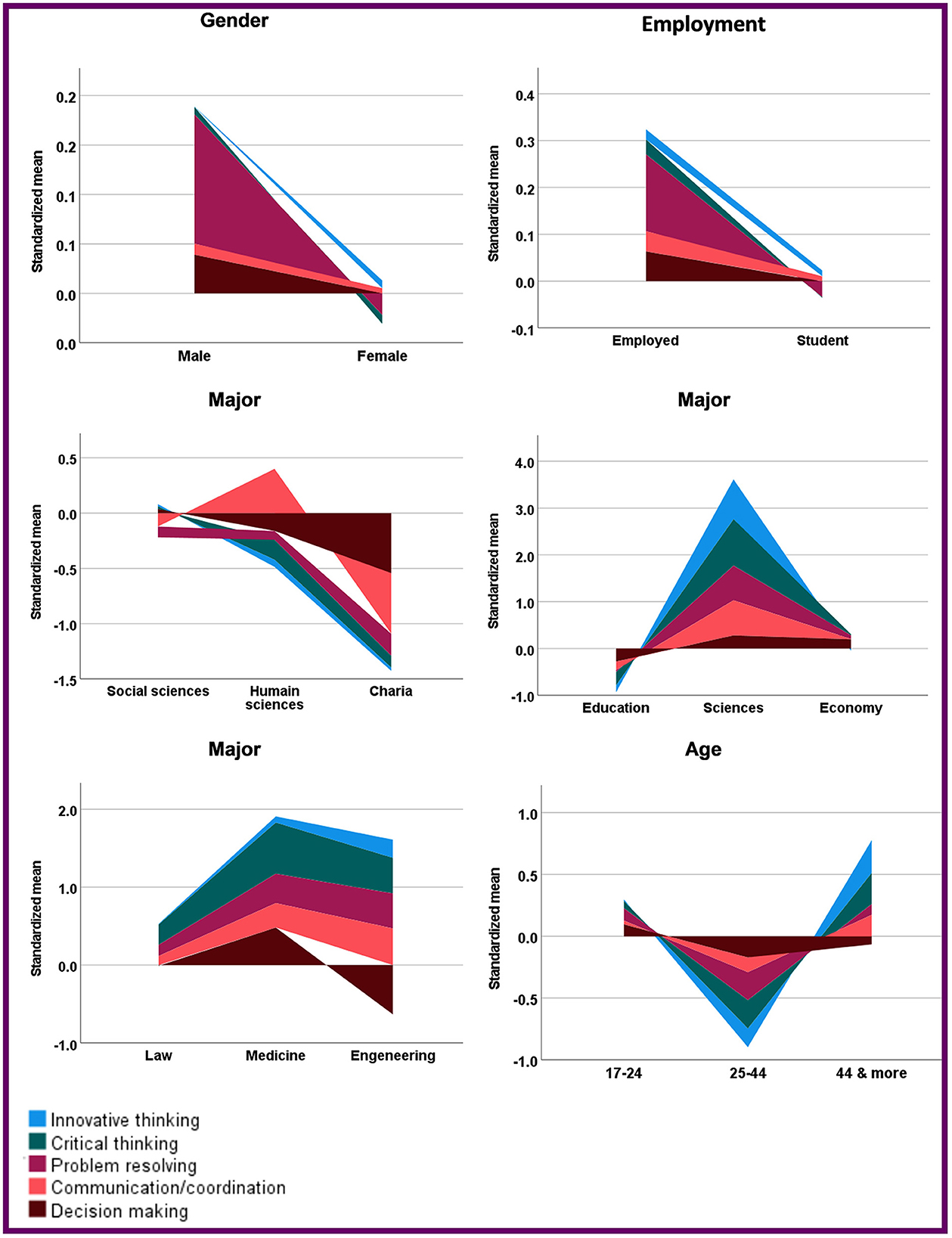
Figure 2. Descriptive sustainable development (SD) skills by student's characteristics (gender, employment, major, and age). *Source: survey data collected at Qatar University (QU) (sample of 319 students).
As shown in Figure 2, male students rated SD skills with higher scores than female students did except for Innovative thinking. Employed students tended to perceive higher SD skills across almost all the SD areas than the unemployed ones, but the differences were not statistically significant. In terms of college majors, students of social sciences, humanities, and Sharia tended to underestimate all SD skills. Students with a science background reported the highest scores (as measured by the standardized mean) in all SD skills, followed by the respondents from medicine, engineering, law, and economy. In terms of age, older students (45 and over) believed that SD skills are important compared to other age groups.
The distribution of SD skills by individual income, the job (or desired job) sector, and GPA is shown in Figure 3. A student with low income rated SD skills to be important with higher scores than the other income groups. Similarly, students with a high GPA placed greater importance on SD skills. The findings also indicated that students expect SD skills to be more effective and more influential in the labor market in healthcare, industry, and finance than in other sectors such as education, engineering, and petroleum.
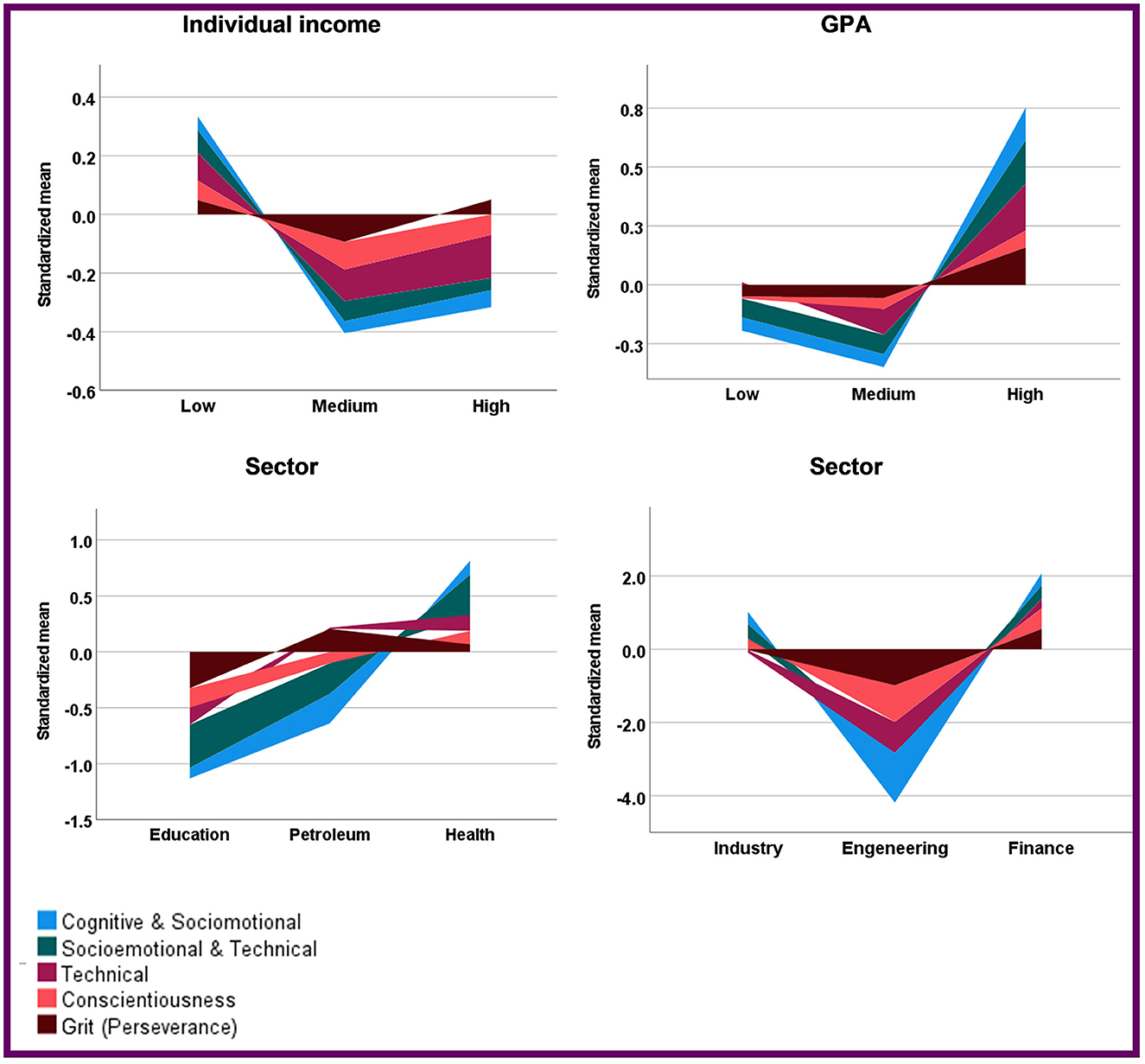
Figure 3. Descriptive SD skills by student's characteristics (individual income, grade point average (GPA), and job sector). *Source: survey data collected at QU (sample of 319 students).
Figure 4 shows that the correlation between the core and SD skills is not too high (<0.3). Nevertheless, Grit (perseverance) tended to be present among the highest correlation coefficient with the majority of SD skills, especially SD1 (innovative thinking), SD4 (communication), and SD5 (decision-making). The linear regression model of the next step quantified the relationship between core and SD skills by controlling all other variables and students' characteristics.
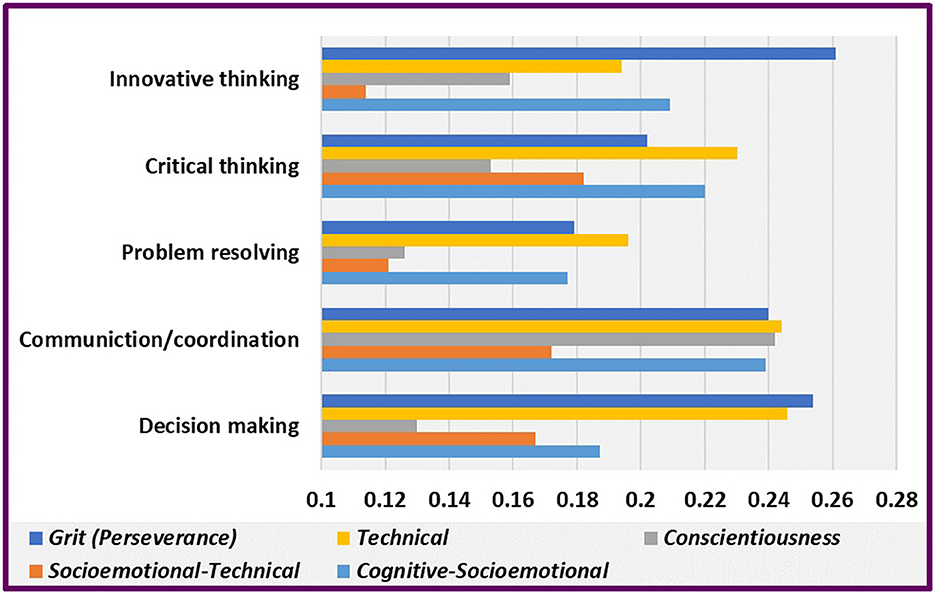
Figure 4. Correlation between the core skills and SD skills. *Source: survey data collected at QU (sample of 319 students).
A multivariate logistic regression analysis was used to find out to what extent the five SD skills could be influenced by the core skill dimensions. Five separate logistic regression models were explored (one for each SD as the dependent variable: Innovative thinking, critical thinking skills, problem-resolving skills, communication/coordination skills, and decision-making skills) using the backward stepwise method to delete the non-significant variables (Hosmer and Lemshow, 2013). To control for all other students' characteristics, we included sociodemographic variables (age, income, gender, employment status, and job sector) and educational variables (GPA, specialization, and credit hour number). To use the SD variable as binary, we recoded “1” for all students who rated the skill as “very important” vs. “0” if not “very important.”
Table 4 presents the final logistic regression model of variables significantly associated with the five SD skills to show the relationship between the independent and dependent variables. The relationship is estimated through odds ratios that quantify the amount of increase in the predicted odds of SD =1 (rated as very important) that would be predicted by a 1-unit increase in the predictor, holding all other predictors constant. In the original SPSS output, the coefficients are in log-odds units and they are often difficult to interpret. Many experts recommend converting the coefficients into odds ratio (OR) (Hagberg and Wegman, 1987). Table 4 displays only the OR labeled “Exp(B).” The odds ratio is interpreted as a measure of association as it approximates the probability (in terms of odds) that the event (or the outcome) is present (Hosmer and Lemshow, 2013). The interpretations of five explored logistic regression models were presented as follows:

Table 4. Multivariate logistic regression model of significant variables associated with five sustainable development (SD) skills.
3.1. Model 1
For every 1-unit increase in “Factor 1: Cognitive–Socio-emotional” score (so, for every additional unit on this scale), we expect that the odds of considering SD1 as very important increase by 14.71 times, holding all other independent variables constant. Categorical variables have a slightly different interpretation. For example, having (or aspiring to have) a job in the “finance sector,” vs. other sectors increases the odds of considering SD1 as very important by 4.17 times. This model shows only two predictors that increase the odds of SD1. When students give a high score to the Cognitive–Socio-emotional factor or working in finance, they tend to see SD1 (Innovative thinking skills) as very important.
3.2. Model 2
This model showed three predictors that increase the odds of SD2 (Critical thinking skills). This model also shows the importance of “Cognitive–Socio-emotional” skills in SD, particularly concerning SD2. For every 1-unit increase in “Factor 1: Cognitive–Socio-emotional” score (so, for every additional unit on this scale), we expect that the odds of considering SD2 as very important increases by 4.52 times, holding all other independent variables constant. The other predictors are QU2 (Ability/work collaboratively with others) and GPA (the more GPA is high, the more it increases SD2 odds).
3.3. Model 3
This model showed three predictors that increase the odds of SD3 (resolving problem skills). This model also shows the importance of “Cognitive–Socio-emotional” skills in SD related to SD3. The strength of their relationship is similar to a previous model. The most important predictor (with the higher odds) is GPA. Another predictor that increases the odds of SD3 is QU2 (Ability/work collaboratively with others).
3.4. Model 4
This model showed four predictors that increase the odds of SD4 (Communication/coordination skills). The most important predictor (with the highest odds) is SS3 (Grit: Perseverance). For every 1-unit increase in the perseverance scale (0–10), we expect that the odds of considering SD4 as very important increase by 12.94 times, maintaining all other independent variables constant. The other predictor that increases the odds of SD4 is QU2 (Ability/to work collaboratively with others).
3.5. Model 5
This model showed two predictors that increase the odds of SD5 (Decision-making skills). The most important predictor (with the highest odds) is Factor 3 (technical skills). For every 1-unit increase in Factor 3, we expect that the odds of considering SD5 as very important increase by 15.49 times, maintaining all other independent variables constant.
4. Discussion
The present study aimed to examine to what extent the current curriculum and educational structures (core skills) applied by QU contribute to SD skills from students' attitudes. More specifically, this study aimed to (1) identify the main factors that summarize the core skills according to the real experience of QU students from their perspective; (2) describe differences in students' attitudes toward ESD according to their characteristics (sociodemographic, GPA, etc.); and (3) determine the effect of the learned core skills on ESD by quantifying this relationship using logistic regression models.
Answering the first question, we found that the original dimensions of skills were not completely independent from each other but tended to share some commonalities (Hiles, 2018). For example, some studies found that the correlation between socio-emotional skills and cognitive characteristics was high. Better cognitive developmental characteristics lead to better social-emotional skills (Coskun and Meral, 2019). According to these authors, cognitive skills can make a difference between individuals in such a way that they will develop social-emotional skills mainly in the domain where information regarding empathy and facial emotion recognition must be processed. This example supports the idea that some aspects of social-emotional skills can be associated with the same factor of cognitive skills, as shown in our results. However, the interference between technical and socio-emotional skills depends on the professional experience. Frequent situations of job interaction involve both technical and socio-emotional skills, especially in teamwork, cooperation with coworkers, or contact with customers (Talavera and Juan, 2007). This might be the reason we found that some of the socio-emotional skills were loaded with the same factor as technical skills. It is also necessary to consider the sociocultural influence in such a way that people rate their skills in self-surveys. Depending on respondents' experiences and cultural background, they may differ in the process of attaching specific meanings when evaluating selected skills (Qiong, 2017). There is a diversity of perceptions among societies, leading to different interpretations when evaluating certain dimensions of life, including school experience (Samovar et al., 2009). This may be why the current study reveals a different suggested model on skill reclassification, as shown in Figure 1, compared to the original model (Table 1). This result is particularly important as it can be used to conduct comparative studies on ESD skills in similar societies. The proposed classification may also offer different perspectives to monitor possible changes regarding the application of ESD in higher education.
The second question of the current study concerns the sociodemographic and other student characteristics of ESD. Except for innovative thinking, we noted that male students rated SD skills with higher scores than female students. Although ESD has been considered a teaching approach that may play a key role in diminishing the gender gap (Olsson and Niklas, 2017), the difference was not statistically significant in the current data. After examining the distribution, it was found that female students were highly represented at the top and bottom of the distribution, but male students were highly represented in the middle of the distribution. For the attitudes toward SD due to differences in employment, our result compels us to ponder if there is a mutual relationship between sustainability skills and work experience. In many societies, the transition from the education system to the workplace poses a great challenge. According to the International Labor Organization, internship opportunities and access to initial professional experience can greatly facilitate this transition in the context of SD (ILO, 2010).
In terms of differences in college majors, the study suggests that the consciousness of students from the college of science was enhanced because the college majors focused more on the environmental dimension as one of the three dimensions of SD in addition to the social and economic dimensions. In contrast, although QU has integrated many courses and practices to disseminate ESD culture, some programs still face difficulties in exploiting such regimes. For instance, students of social sciences are still dependent more on theoretical concepts and are characterized by a lack of application. However, there are some generic dimensions of skills in which students tend to perceive the same learning opportunities, regardless of their field of study (Lohberger and Edith, 2022). On the other hand, we found that older students believe that SD skills are important compared to other age groups. This may be because there are many professional opportunities that require more accurate exposure to SD skills in the ground. The targeting strategy should be oriented toward the younger age groups who do not have the same experience through scientific and practical mechanisms, such as internships, regularly during their university study (Jackson, 2018). A student with low income rated SD skills as important and with higher scores than the other income groups. Considering that income is a component of human capital from the perspective of the sustainability literature, this finding is consistent with the notion that high-income earners tend to develop human capital at the expense of natural capital (Hediger, 2006; Davies, 2013). Similarly, students with a high GPA place more emphasis on SD skills. These students are more interested in achieving educational outcomes as per the requirements of educational programs that focus on SD skills, i.e., critical thinking skills. Many studies also showed that students with high GPA scores (students who perform well in their academic careers) have more positive attitudes toward SD skills than those with low GPA scores (Al-Naqbi and Alshannag, 2018).
Our findings indicate that students expect SD skills to be more effective and influential in the labor market in healthcare, industry, and finance than in other sectors such as education, engineering, and petroleum. Health workers tend to be more aware of the importance of SD skills, especially in terms of creating a healthy environment suitable for doing business, than other sector workers. For the petroleum sector, this result corresponds to the reality that the proportion of environmental pollution associated with this sector in Qatar is increasing at very high rates (WHO, 2020), as well as engineering and construction projects. These sectors are considered to be among the most important sources of environmental pollution in the country, and as such, respondents in this sector are probably less sensitive to SD skills.
The third question of the current study examined the relationship between the acquired skills at the university and SD skills (innovative thinking, critical thinking, resolving problems, communication, and decision-making). Our five multivariate logistic regression models show many interesting findings. Model 1 suggests that the enhancement of SD1 (Innovative thinking skills) is associated with Cognitive–Social-emotional skills. Many studies conceptualized innovative thinking as a cognitive process leading to innovation (Morad et al., 2021). Other studies have used the concept of cognitive flexibility to show its relationship with innovative skills (Isen, 2002; Georgsdottir and Isaac, 2004; Voica and Singer, 2013). Cognitive flexibility is very important in such a way that a person acquires knowledge through positive interactions with surrounding settings, takes advantage of available learning opportunities, and deals with the changes that are part of a complex and rapidly changing world; therefore, individuals can enhance their innovative thinking skills required for SD. This flexibility is consistent with the idea of linking cognitive skills with socio-emotional skills through our factor “Cognitive–Socio-emotional” due to the importance of the student's relationships with his surroundings from a Socio-emotional perspective, which determines the relevance of the acquired knowledge. This is logical as the greater the student's ability to interact positively with the environment, the greater the opportunities and attitudes to develop and creatively use knowledge.
In model 2, three predictors were found to be associated with SD2 (Critical thinking skills). As shown in the results, many studies confirmed the correlation between critical thinking skills and cognitive abilities (Tuaputty et al., 2021). Critical thinking skills are closely related to an active and organized cognitive process that helps students understand themselves and become familiar with what is happening around them. They can be aware of their thinking process, as well as consider the thought processes of others to be able to efficiently apply what they already know (Danczak et al., 2020). Critical thinking requires cognitive skills (Hart et al., 2021) as students must have a high level of abstract and logical thinking, which can only be acquired through the effective use of knowledge. Thus, students can adopt good critical reasoning that focuses on deciding what they believe and they can do (van Peppen et al., 2018).
In the third model of our multivariate regressions, we found that three predictors (including Cognitive–Socio-Emotional) increase the odds of SD3 (Resolving problem skills). Wang and Vincent (2008) mentioned, “The problem solving is a cognitive process of the brain that searches a solution for a given problem or finds a path to reach a given goal.” According to their study, the process of resolving a problem depends on cognitive skills in such a way that students need to find in the memory space a relationship between a set of solution goals and a set of alternative paths.
Model 4 differs slightly from previous models and shows that the most important predictor of SD4 (Communication/coordination skills) is Grit (perseverance). Grit is related to successful outcomes as it emphasizes persistence on tasks and consistency in goal pursuit. It is considered one of the prerequisites for higher performance and a key skill for achieving the educational goals associated with SD (Andersson and Bergman, 2011). In model 5, we found that the most important predictor of SD5 (decision-making skills) was technical skills. As it was integrated into technical skills, the development of decision-making skills among students was considered an effective pathway to achieve SD. Several articles showed that there is evidence of a relationship between technical skills and decision-making (Farrell, 1999; Lopes et al., 2016). Farrell (1999) mentioned that the personnel at the headquarters of a military organization are often more expert in specific technical areas related to SD and can therefore make significant decisions. However, other studies have shown that technical decisions are not solely rational; there is always an emotional element in a decision made by humans (Kranabitl et al., 2021). According to these studies, the decision-making approach needs to consider the human factor as well as technical facts and knowledge.
5. Conclusion
This study discussed the abovementioned three main questions and concluded that: (1) the classification of core skills may differ according to the sociocultural background of students; (2) the socioeconomic and demographic determinants may affect students' attitudes toward SD skills; and (3) the impact level of core skills varies according to the type of SD skills.
Previous studies tended to use conventional models to classify skills according to the usual outcomes in higher education. The contribution of our study is that it presents a model that considers the potential for skills to overlap with each other depending on the sociocultural context of a society. This article considers the social context in which university students' core skills, as well as their attitudes toward SD skills, are developed. Therefore, the classification of core skills may differ according to the real experiences of students and the society to which they belong. Thus, we considered that a new classification presented in this study may reflect social reality. In addition, many core skills may share some commonalities. For example, the combination of cognitive and socio-emotional skills tends to be logical, as we built it on factor analysis so that, sometimes, the importance of cognitive skills cannot be considered without emotional expressions that determine their effectiveness. The knowledge acquired depends on the importance of the student's relationships with his/her surroundings from a socio-emotional behavior. The greater the student's ability to interact positively with the environment, the greater the opportunities and attitudes to develop knowledge and employ it creatively. Therefore, this study proposes a new classification of core skills to be applied to similar societies. The yielded classification offers a new approach to the impact that the educational system in universities can have on the development of ESD.
Some core education outcomes have a higher impact on achieving SD skills (Figure 5). Our study accurately quantifies relationships between core skills on the one hand and SD skills on the other hand. Such a contribution may guide policies in restructuring educational programs and curricula, especially for high-impact core skills. This contributes to a deeper discussion of educational pathways in the higher education sector and its related theories in future research. Developing ESD skills is an effective pathway to keep pace with contemporary social, economic, and environmental changes and to prepare individuals to realize their present and future aspirations and achieve an SD agenda. The study opens up prospects for an important hypothesis: possession of the core skills would bring about the expected transformation of ESD that would enable societies to meet the needs of the current generation without affecting the opportunity to meet the needs of future generations. Ultimately, similar studies may be applied to other societies to observe how core skills contribute to SD and what changes are expected in the 2030 outlook, especially concerning the new educational challenges the world has experienced due to the COVID-19 pandemic.
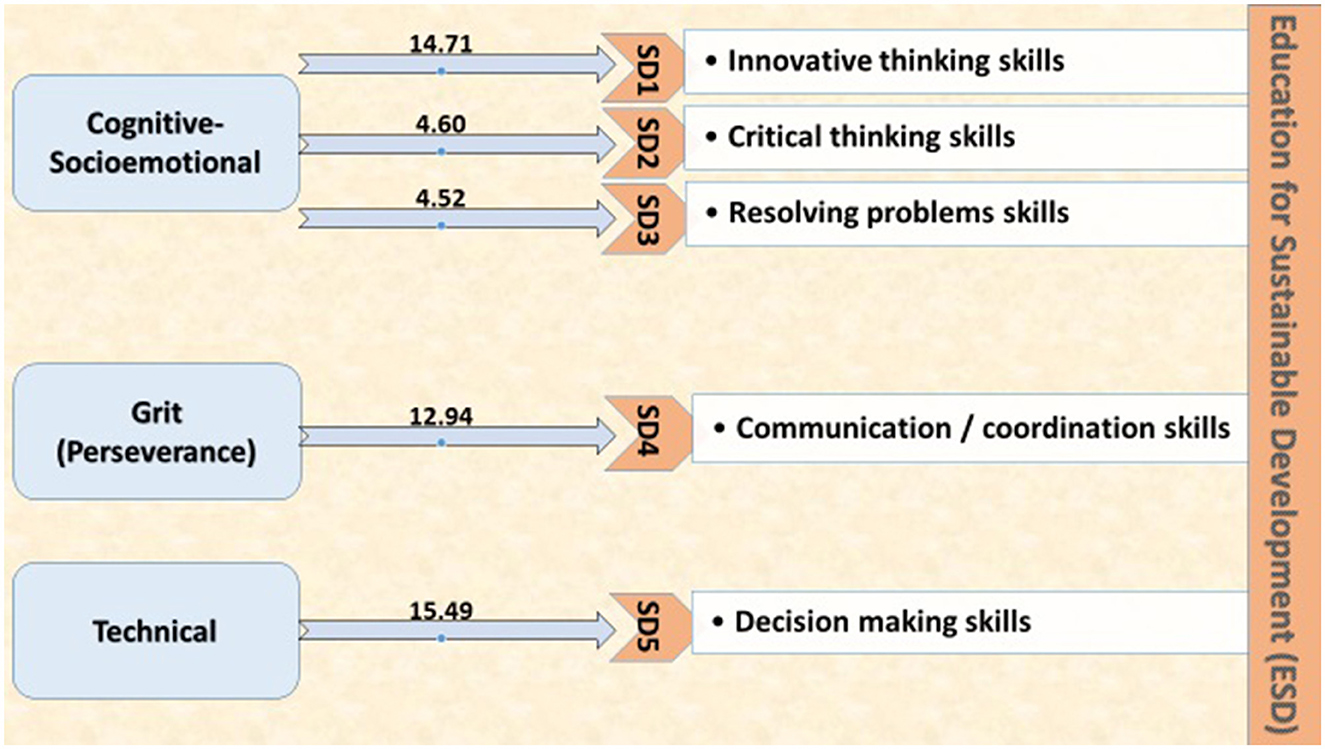
Figure 5. The effect of core skills on ESD skills. We displayed in this figure only the core skills associated to SD skills in logistic regression models. Table 4 shows all the other significant variables in the explored regression models [GPA, QU2: ability/work collaboratively with others, and job (or desired-job) sector “Finance”].
Data availability statement
The raw data supporting the conclusions of this article will be made available by the authors, without undue reservation.
Ethics statement
The studies involving human participants were reviewed and approved by the Qatar University Institutional Review Board QU-IRB. Written informed consent for participation was not required for this study in accordance with the national legislation and the institutional requirements.
Author contributions
AA and A-SA conceptualized the study, designed the questionnaire, wrote the first draft of the literature review, wrote the discussion, and conclusion. HR validated the data used, contributed to the statistical analysis, and wrote the results. All authors contributed to the manuscript revision and read and approved the submitted version.
Conflict of interest
The authors declare that the research was conducted in the absence of any commercial or financial relationships that could be construed as a potential conflict of interest.
Publisher's note
All claims expressed in this article are solely those of the authors and do not necessarily represent those of their affiliated organizations, or those of the publisher, the editors and the reviewers. Any product that may be evaluated in this article, or claim that may be made by its manufacturer, is not guaranteed or endorsed by the publisher.
Footnotes
References
Acosta Castellanos, P. M., and Queiruga-Dios, A. (2022). From environmental education to education for sustainable development in higher education: a systematic review. Int. J. Sust. Higher Educ. 23, 622–644. doi: 10.1108/IJSHE-04-2021-0167
Acosta, P., Takiko, I., Rosechin, O., and Jan, R. (2017). Developing Socioemotional Skills for the Philippines' Labor Market. Edited by Wrold Bank Group. Available online at: https://www.worldbank.org/en/country/philippines/publication/developing-socioemotional-skills-for-the-philippines-labor-market (accessed January 5, 2023).
Ali, A. S. M. (2013). Targeting the poorest in developing countries: components of multidimensional deprivation in Luxor, Egypt. Int. J. Sust. Dev. World Ecol. 20, 504–511. doi: 10.1080/13504509.2013.842946
Ali, A. S. M., Hoshino, S., and Hashimoto, S. (2020). Towards an overarching analysis of social exclusion in the arab countries ([special feature] political change and migration from the middle east) a case study from Egypt. Annal. Japan Assoc. Middle East Stu. 36, 175–200. doi: 10.24498/ajames.36.1_175
Al-Naqbi, A. K., and Alshannag, Q. (2018). The status of education for sustainable development and sustainability knowledge, attitudes, and behaviors of UAE University students. Int. J. Sust. Higher Educ. 19, 566–588. doi: 10.1108/IJSHE-06-2017-0091
Amado Mateus, M., Guzmán Rincón, A., and Cuero Acosta, Y. A. (2023). Student experience scale: factor analysis in higher education institutions. Front. Educ. 7, 1057651. doi: 10.3389/feduc.2022.1057651
Andersson, H., and Bergman, L. R. (2011). The role of task persistence in young adolescence for successful educational and occupational attainment in middle adulthood. Dev. Psychol. 47, 950–960. doi: 10.1037/a0023786
Coskun, K., and Meral, C. (2019). Is socio-emotional development correlated with cognitive development among children? Education 139, 127–130.
Danczak, S. M., Thompson, C. D., and Overton, T. L. (2020). Development and validation of an instrument to measure undergraduate chemistry students' critical thinking skills. Chem. Educ. Res. Prac. 21, 62–78. doi: 10.1039/C8RP00130H
Davies, G. R. (2013). Appraising weak and strong sustainability: searching for a middle ground. J. Sust. Dev. 10, 111–124. Availble online at: https://www.semanticscholar.org/paper/Appraising-weak-and-strong-sustainability%3A-for-a-Davies/196a822b39d0f5abbaea5dd638c92fabb4fa5f1e (accessed April 8, 2023).
Farrell, A. (1999). Sustainability and decision-making: the epa's sustainable development challenge grant program. Policy Stu. Rev. 16, 3. doi: 10.1111/j.1541-1338.1999.tb00878.x
Fekih, Z., Dubis, S., and Koç, M. (2021). Embedding education for sustainable development (ESD) and SDGs values in curriculum: a comparative review on Qatar, Singapore and New Zealand. J. Cleaner Prod. 319, 128534. doi: 10.1016/j.jclepro.2021.128534
Georgsdottir, A. S., and Isaac, G. (2004). How flexibility facilitates innovation and ways to manage it in organizations. Creat. Innov. Manage. 13, 166–175. doi: 10.1111/j.0963-1690.2004.00306.x
Glavič, P. (2020).Identifying key issues of education for sustainable development. Sustainability 12, 16. doi: 10.3390/su12166500
Hagberg, M., and Wegman, D. H. (1987). Prevalence rates and odds ratios of shoulder-neck diseases in different occupational groups. Br. J. Ind. Med. 44, 602–611. doi: 10.1136/oem.44.9.602
Hart, C., Costa, D. a, D'Souza, C., Kimpton, D. A., and Ljbusic, J. (2021). Exploring higher education students' critical thinking skills through content analysis. Thinking Skills Creativity 41, 100877. doi: 10.1016/j.tsc.2021.100877
Hediger, W. (2006). Weak and strong sustainability, environmental conservation and economic growth. Nat. Res. Model. 19, 359–394. doi: 10.1111/j.1939-7445.2006.tb00185.x
Hiles, M. I. (2018). Cohort Culture and the Student Voice in Creative and Media Subjects in UK Higher Education. Bournemouth: Bournemouth University
Hoban, J. D., Lawson, S. R., Mazmanian, P. E., Best, A. M., and Seibel, H. R. (2005). The self-directed learning readiness scale: a factor analysis study. Med. Educ. 39, 370–379. doi: 10.1111/j.1365-2929.2005.02140.x
ILO (2010). A Skilled Workforce for Strong, Sustainable and Balanced Growth. Available online at: https://www.oecd.org/g20/summits/toronto/G20-Skills-Strategy.pdf (accessed January 5, 2023).
Isen, A. M. (2002). Missing in action in the aim: positive affect's facilitation of cognitive flexibility, innovation, and problem solving. Psychol. Inquiry 13, 57–65. Availbale online at: https://www.jstor.org/stable/1449541 (accessed April 8, 2023).
Jackson, D. (2018). Developing graduate career readiness in australia: shifting from extra-curricular internships to work-integrated learning. Int. J. Work Int. Learn. 19, 23–35. Available online at: https://eric.ed.gov/?id=EJ1179832 (accessed April 8, 2023)
Kranabitl, P., Clemens, F., and Hannes, H. (2021). Decision making for sustainable technical applications with the smh approach. Sustainability 13, 702. doi: 10.3390/su13168702
Leal Filho, W., Raath, S., Lazzarini, B., Vargas, V. R., Souza, L., Anholon, R., et al. (2018). The role of transformation in learning and education for sustainability. J. Cleaner Prod. 199, 286–295. doi: 10.1016/j.jclepro.2018.07.017
Lleras, C. (2008). Do skills and behaviors in high school matter? The contribution of noncognitive factors in explaining differences in educational attainment and earnings. Soc. Sci. Res. 37, 888–902. doi: 10.1016/j.ssresearch.2008.03.004
Loewenthal, K. M. (2001). An Introduction to Psychological Tests and Scales. London: Taylor and Francis Inc.
Lohberger, K., and Edith, B. (2022). Comparing learning opportunities of generic skills in higher education to the requirements of the labour market. Front. Educ. 7, 886307. doi: 10.3389/feduc.2022.886307
Lopes, M. C., Magalhães, R. T., Diniz, L. B. F., Moreira, J. P. A., and Albuquerque, M. R. (2016). The influence of technical skills on decision making of novice volleyball players. Rev. Bras. Cineantropometr. Desempenho Hum. 18, 362–370. doi: 10.5007/1980-0037.2016v18n3p362
Malik, R. S. (2018). Educational challenges in 21st century and sustainable development. J. Sust. Dev. Educ. Res. 2, 9–20. doi: 10.17509/jsder.v2i1.12266
Manalo, E., Kusumi, T., Koyasu, M., Michita, Y., and Tanaka, Y. (2013). To what extent do culture-related factors influence university students' critical thinking use?. Thinking Skills Creativity 10, 121–132. doi: 10.1016/j.tsc.2013.08.003
Mensah, J., and Sandra, R. C. (2019). Sustainable development: meaning, history, principles, pillars, and implications for human action: literature review. Cogent Social Sci. 5, 1653531. doi: 10.1080/23311886.2019.1653531
Morad, S., Ragonis, N., and Barak, M. (2021). An integrative conceptual model of innovation and innovative thinking based on a synthesis of a literature review. Thinking Skills Creativity 40, 100824. doi: 10.1016/j.tsc.2021.100824
Olafsen, A. H., Nilsen, E. R., Smedsrud, S., and Kamaric, D. (2021). Sustainable development through commitment to organizational change: the implications of organizational culture and individual readiness for change. J. Workplace Learn. 33, 180–196. doi: 10.1108/JWL-05-2020-0093
Olsson, D., and Niklas, G. (2017). The effect of gender on students' sustainability consciousness: a nationwide swedish study. J. Environ. Educ. 48, 357–370. doi: 10.1080/00958964.2017.1310083
Qiong, O. (2017). A brief introduction to perception. Stud. Literature Lang. 15, 18–28. doi: 10.3968/10055 Available online at: https://core.ac.uk/download/pdf/236304229.pdf (accessed April 8, 2023).
Rayman-Bacchus, L., and Radavoi, C. N. (2020). Advancing culture's role in sustainable development: social change through cultural policy. Int. J. Cultural Policy 26, 649–667. doi: 10.1080/10286632.2019.1624735
Salas Velasco, M. (2014). Do higher education institutions make a difference in competence development? A model of competence production at university. Higher Educ. 68, 503–523. doi: 10.1007/s10734-014-9725-1
Samovar, L. A., Richard, E. P., and Edwin, R. M. (2009). Communication Between Cultures: Wadsworth. Boston, MA: Cengage Learning.
Sharma, N. (2020). Value-Creating Global Citizenship Education for Sustainable Development: Strategies and Approaches. Cham: Springer.
Talavera, E. R., and Juan, C. G. (2007). Training in socioemotional skills through on-site training. Eur. J. Voc. Train. 40, 83–102. Available online at: https://www.semanticscholar.org/paper/Training-in-socio-emotional-skills-through-on-site-Talavera-P%C3%A9rez-Gonz%C3%A1lez/7bc965a505cc4173bed05fc125fa4c4d67685d65 (accessed April 8, 2023).
Tuaputty, H., Leasa, M., Corebima, A. D., and Batlolona, J. R. (2021). The correlation between critical thinking skills and cognitive learning outcomes. Educ. Online 20, 302–317. doi: 10.17051/ilkonline.2021.01.029
UNESCO (2014). Aichi-Nagoya Declaration on Education for Sustainable Development. Available online at: https://sustainabledevelopment.un.org/content/documents/5859Aichi-Nagoya_Declaration_EN.pdf (accessed December 6, 2022).
UNESCO (2020). Education for Sustainable Development: A Roadmap. Available on line at: https://unesdoc.unesco.org/ark:/48223/pf0000374802.locale=en (accessed January 5, 2023).
van Peppen, L. M., Peter, P. J. L., Verkoeijen Anita, E. G, Heijltjes Eva, M., Janssen, D., and Tamara, G. (2018). Effects of self-explaining on learning and transfer of critical thinking, skills. Front. Educ. 3, 100. doi: 10.3389/feduc.2018.00100
Voica, C., and Singer, F. M. (2013). Problem modification as a tool for detecting cognitive flexibility in school children. ZDM 45, 267–279. doi: 10.1007/s11858-013-0492-8
Wang, Y., and Vincent, C. (2008). On the cognitive process of human problem solving. Cognit. Syst. Res. 11, 81–92. doi: 10.1016/j.cogsys.2008.08.003
WHO (2020). World Air Quality Report Region and City Pm2, 5. Ranking. Available online at: https://www.iqair.com/world-most-polluted-cities/world-air-quality-report-2020-en.pdf (accessed April 8, 2025).
Keywords: higher education, sustainable development, logistic regression, core skills, Qatar
Citation: Alshawi AAH, Ali A-SM and Raïq H (2023) Skill components of higher education in the era of sustainable development: an analytical study among university students in Qatar. Front. Educ. 8:1141306. doi: 10.3389/feduc.2023.1141306
Received: 10 January 2023; Accepted: 20 March 2023;
Published: 17 April 2023.
Edited by:
Terrell Lamont Strayhorn, Illinois State University, United StatesReviewed by:
Pedro Gil-Madrona, University of Castilla-La Mancha, SpainCigdem Hursen, Near East University, Cyprus
Copyright © 2023 Alshawi, Ali and Raïq. This is an open-access article distributed under the terms of the Creative Commons Attribution License (CC BY). The use, distribution or reproduction in other forums is permitted, provided the original author(s) and the copyright owner(s) are credited and that the original publication in this journal is cited, in accordance with accepted academic practice. No use, distribution or reproduction is permitted which does not comply with these terms.
*Correspondence: Ali A. Hadi Alshawi, ZHJfYWxzaGF3aUBxdS5lZHUucWE=
 Ali A. Hadi Alshawi
Ali A. Hadi Alshawi Abdel-Samad M. Ali
Abdel-Samad M. Ali Hicham Raïq
Hicham Raïq